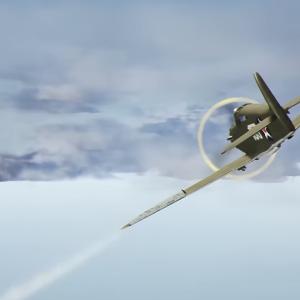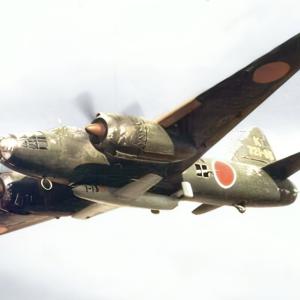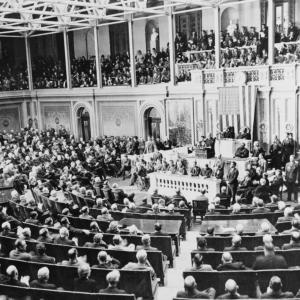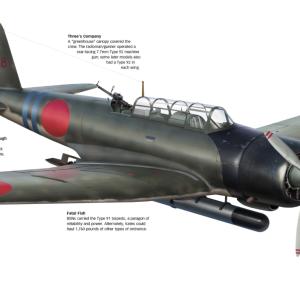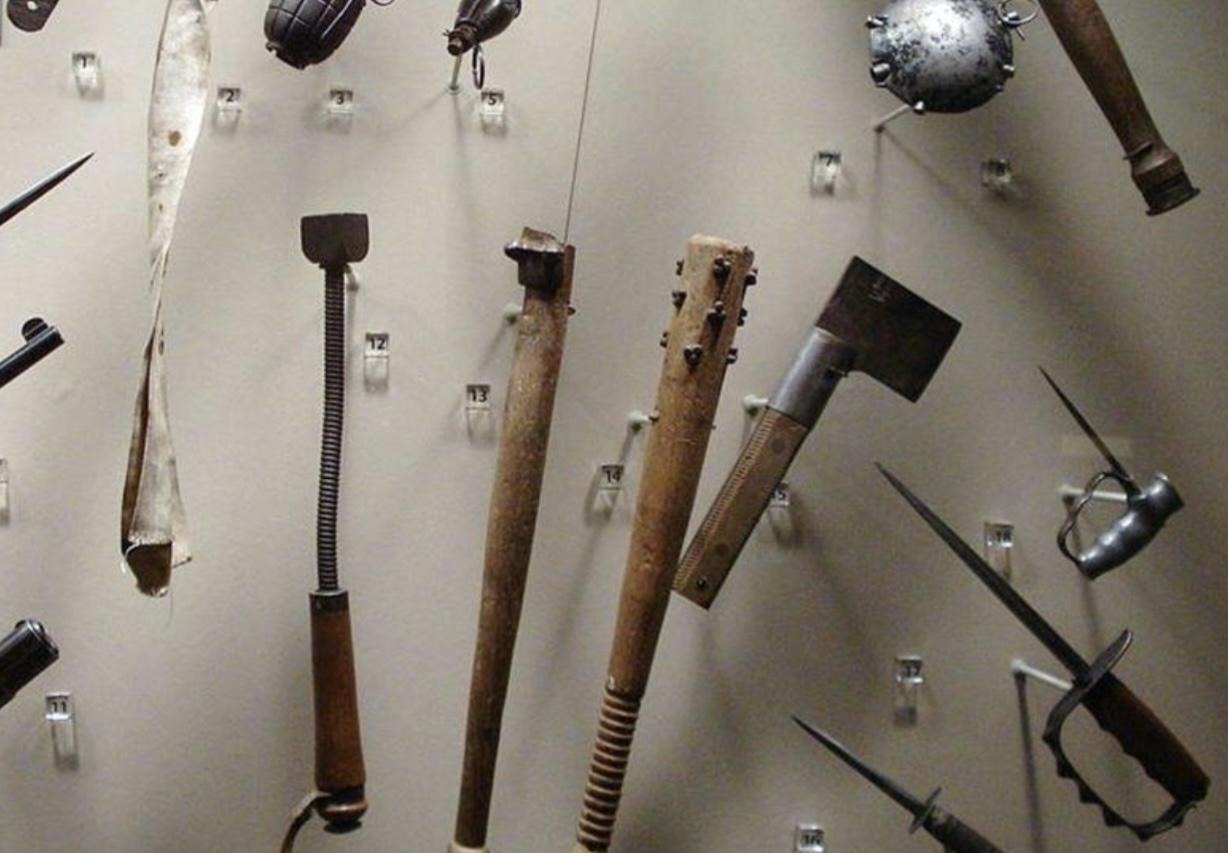
Trench warfare hand held weapons
Trench warfare in World War I introduced a brutal form of close-quarters combat that required a variety of handheld weapons. The nature of life in the trenches—with narrow, confined spaces and frequent raids—meant that soldiers relied not only on their rifles but also on a wide range of compact, personal weapons. These handheld arms were crucial in close combat, patrols, and trench raids, where stealth, speed, and lethal force were essential. From bayonets to clubs and pistols, the handheld weapons of trench warfare offer a glimpse into the gritty and personal nature of World War I combat.
The most common handheld weapon carried by infantry was the bolt-action rifle. While technically a firearm, these rifles were portable and individually operated by a single soldier, making them handheld by definition. The British Lee-Enfield, German Mauser Gewehr 98, and French Lebel rifles were all standard issue. Soldiers were trained to use them effectively under various conditions. These rifles were reliable, accurate, and capable of holding multiple rounds, usually between five and ten. In the trench environment, their length could be a disadvantage in tight spaces, but they remained essential for both defense and offense. They could be fitted with bayonets for close combat, giving them additional functionality.
Bayonets were standard equipment for most soldiers and symbolized the traditional idea of hand-to-hand warfare. These blades, which attached to the muzzle of a rifle, turned a firearm into a spear-like weapon. Although full bayonet charges across open ground became less common due to the high casualty rates, bayonets were still widely used in trench raids and when enemies breached the front lines. The close quarters of the trenches often made rifle-bayonet combinations cumbersome, but shorter bayonets and knife-bayonets were easier to manage. These weapons were also sometimes used separately from rifles as stabbing tools during melee encounters in the dark and cramped trenches.
Trench knives were specifically designed for silent and lethal close combat. These knives varied in shape and size but were usually compact, sturdy, and easy to handle. Some trench knives had brass knuckle grips built into the handle, allowing them to double as punching weapons. Others featured triangular or stiletto-style blades that could penetrate thick uniforms and cause severe injuries. Soldiers used trench knives during night raids and patrols, where stealth and the element of surprise were critical. Their silent lethality made them indispensable for trench raiders tasked with clearing enemy positions without alerting others.
Clubs and blunt instruments were another class of handheld weapons used widely during trench warfare. These crude yet effective weapons were often homemade, crafted from wood, metal, or even parts of rifles. Trench clubs typically featured a heavy head designed to incapacitate or kill with a single blow. Some had nails or metal spikes embedded in them to maximize damage. These clubs were especially useful during surprise trench raids, where stealth was crucial and gunfire might reveal a raider’s position. The use of such weapons reflects the savage and improvised nature of close combat in the trenches.
Entrenching tools, such as small shovels or spades issued to every soldier for digging, were frequently repurposed as melee weapons. In the heat of battle, soldiers wielded these tools like axes or clubs. Their sturdy, metal construction made them surprisingly effective in hand-to-hand fighting. When sharpened, an entrenching tool could be used to slash or stab an enemy, making it a dual-purpose item—part utility tool, part deadly weapon. Given their constant presence and easy access, these tools became one of the most common improvised weapons in trench warfare.
Hand grenades also fall under the category of handheld weapons, even though they are thrown rather than wielded in melee combat. Grenades were vital for clearing enemy trenches, bunkers, and dugouts. Soldiers carried various types of grenades, from fragmentation models designed to send lethal shrapnel flying through the air to concussion grenades intended to deliver a powerful blast. The British Mills bomb was a popular fragmentation grenade, while the German Model 24 Stielhandgranate, known for its long wooden handle, provided additional throwing leverage. These compact explosives were key tools in both offense and defense, enabling soldiers to inflict damage without direct line-of-sight contact.
Pistols and revolvers served as personal defense weapons, particularly for officers, machine gunners, and trench raiders. Although less common than rifles, pistols were prized for their compactness and quick draw in tight spaces. The British Webley revolver, the German Luger P08, and the American Colt M1911 were all used during the war. Pistols were effective in the close confines of trench systems, especially during surprise engagements or in dugouts where maneuvering with a rifle was impractical. Their limited range and ammunition capacity were disadvantages, but their ease of use in emergencies made them valuable sidearms.
Improvised handheld weapons were common among soldiers who had to make do with what they had. These included tools modified with spikes, heavy bolts attached to sticks, and even sharpened pieces of metal tied to wood. Such weapons were often created by soldiers on the front lines for use during night raids or when ammunition was scarce. The chaotic nature of trench combat encouraged innovation, and many soldiers developed unique weapons suited to their own fighting style or specific mission requirements. These improvised weapons further illustrate how personal and brutal trench warfare could be.
Axes and hatchets were occasionally issued or carried for utilitarian purposes but were also used as combat weapons. Their weight and sharp edges made them effective in melee situations. While not standard-issue weapons for most soldiers, they were sometimes used by specialized units or trench raiders. Their ability to deliver powerful strikes made them formidable in hand-to-hand combat, and their utility value for cutting wood or clearing obstacles increased their usefulness in the field.
Blackjacks and saps, similar to clubs but typically more compact and easier to conceal, were used by raiders and scouts during stealth operations. These short, flexible weapons consisted of leather or fabric pouches filled with lead or sand and were designed to incapacitate enemies with minimal noise. Used mainly by soldiers who needed to eliminate sentries silently, these weapons reflect the covert side of trench warfare, where certain missions required a quiet approach rather than open gunfire.
The brutality and effectiveness of handheld weapons during trench warfare highlight the grim realities faced by soldiers on the front lines. In environments where long-range weapons were ineffective or unavailable, personal and improvised tools became essential for survival. The combination of standard-issue gear, like rifles and bayonets, and improvised or specialized tools, such as clubs and trench knives, underscored the adaptability of troops facing one of the most grueling combat conditions in history.

